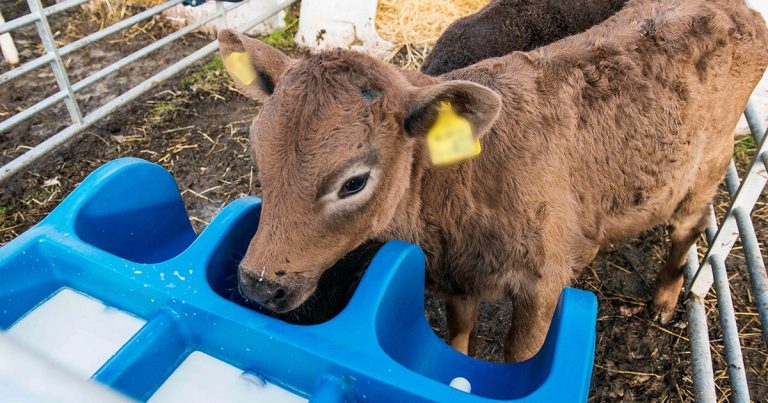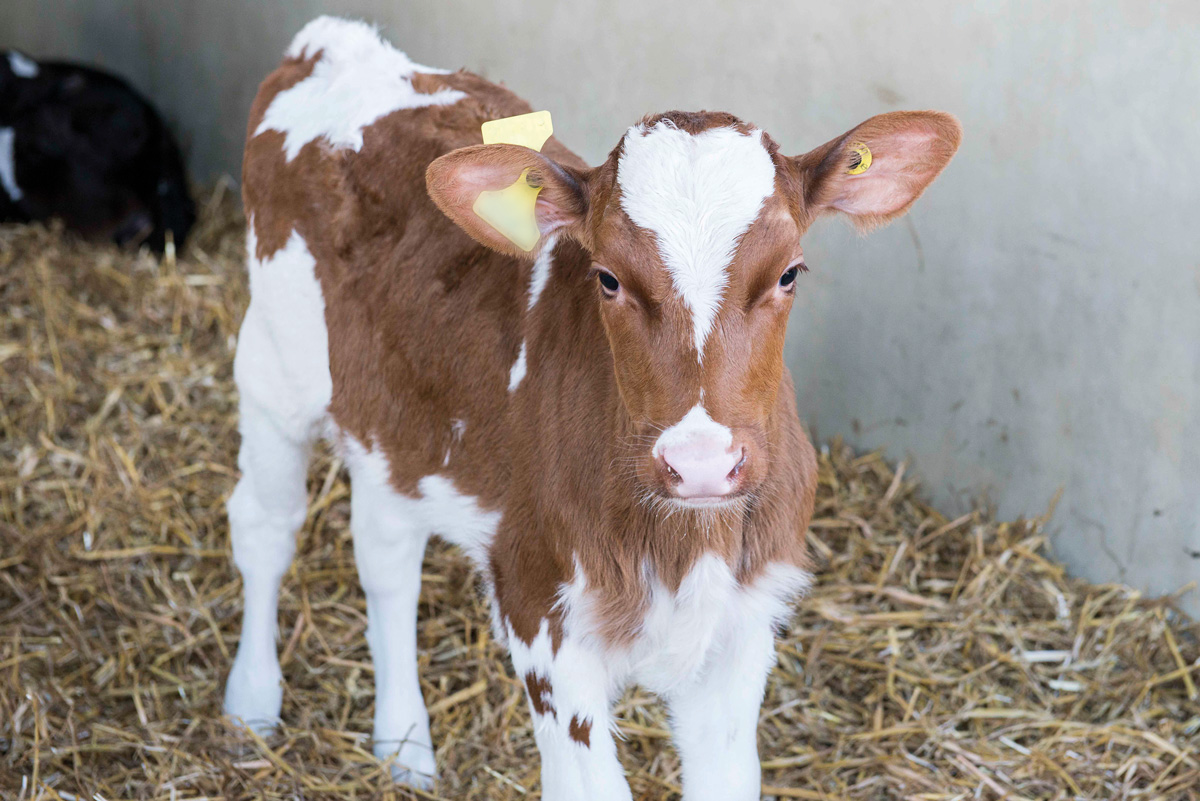5 Dec 2023
Neonatal calf diarrhoea: advising farmers of vaccination benefits
SPOTLIGHT: Tom Warboys shares the ways in which veterinarians can advise clients on improving the health of youngstock on dairy farms.

Youngstock health remains a significant challenge on dairy farms. Pre-weaning mortality sits at 4.5% (Johnson et al, 2017), with another study finding 11.3% heifer calves died within the first month (Brickell and Wathes, 2011).
The primary causes of disease in UK dairy heifers, diarrhoea and bovine respiratory disease (BRD), affect on average 48.2% and 45.9% of calves, respectively (Johnson et al, 2021).
Neonatal disease has many impacts, including the following:
- On animal welfare through increased disease or mortality.
- On productivity through reduced growth and future yields, delayed first calving and early culling.
- On human health through increasing antimicrobial use and on well-being through increased time and stress dealing with disease.
- On carbon intensity due to inefficient resource use, which is being monitored on some farms (as is youngstock performance) according to milk contract standards.
Management
As with BRD, a range of pathogens might be involved in clinical scours cases. This makes improvements in management more effective at disease control than targeting individual infectious agents.
Nutrition, hygiene and colostrum control are all regularly highlighted as key (Hyde et al, 2021; Johnson et al, 2017).
Calf factors
Failure of passive transfer (FPT) is a key risk factor for scours and BRD, and may be present in 26% of calves in the UK (MacFarlane et al, 2015). The “three Qs” of feeding colostrum (quality, quantity, quickly) all require constant attention if FPT is to be avoided.
Quality begins with dam status: health, age (third lactation and older), trace element (selenium) supplementation, dry period length (over three weeks) and dietary protein all improve quality. It is also essential to milk the dam promptly, as quality decreases by 3.7% per hour after calving, and refrigerate or freeze colostrum within an hour of milking (Godden et al, 2019).
Brix refractometers are cheap and simple to use, and a cut-off of 22% will ensure colostrum contains at least 50g/L immunoglobulins. Poor hygiene will increase infection risk to the calf, as well as reduce immunoglobulins.
Following colostrum from harvesting through to feeding is often required since some issues will not be identified by the farmer (for example, temporarily storing in open buckets in the parlour). Colostrum replacers often have to be fed in much higher amounts than suggested to avoid FPT (Godden et al, 2019). Quantity (10% of calf weight) and quickly (which constitutes 3L within six hours and another 3L within 12 hours) are commonly discussed on farm. A fourth “Q”, quietly, can be added as stress has been shown to reduce protein absorption.
Although colostrum fed after the first day of life will not impart further systemic immunity (at least through immunoglobulins), a local advantage to continued IgG presence in the gut is thought to exist. Additionally, many hormone signals in colostrum and transition milk exist that are highly beneficial. Therefore, feeding transition milk for the first week of life continues to benefit the calf.
Nutritional status of calves following colostrum feeding continues to influence scour risk. Feeding milk replacers at an appropriate concentration and volume, and with attention to consistent temperature and hygiene, is key. Many different protocols exist, but 8L per day at a concentration of 125g/L (or at least 900g of milk powder, fed at a maximum concentration of 150g/L) is a good start.
‘If colostrum, hygiene and feeding are reasonable, then scours vaccination can have significant benefits in reducing clinical disease in any infected animals.’
Environmental factors
Aside from colostrum, reducing the pathogen load in the environment is the most important factor in scours control.
The recommended stocking density from birth is at the very least 2m2 per calf of bedded area and by two months old should be 3m2 per calf; this is considerably more allowance than the statutory requirement of 1.5m2 (Sherwin et al, 2016).
Increasing stocking density causes competition for feed and water, and necessitates more frequent cleaning out. Ideally, feed and water should be provided on a non-bedded, well-draining surface, so much of the moisture generated by feeding and drinking remains separate to the lying area.
The lower critical temperature (the air temperature below which calves have to divert energy away from growth and fighting disease to heat production) is variable, but can be as high as 20°C for newborn calves. Extra feeding (plus 25%) may be indicated at lower temperatures to protect neonates; a 5°C increase in temperature is correlated with a 60g/d increase in liveweight gain (Hyde et al, 2021).
In UK winters, additional feeding and/or heat sources in the form of shelters within pens, heat lamps or calf jackets must be provided, and calves must remain dry at all times; in the author’s own research, he has found calf jackets only improve weight gains on farms with good initial calf health, highlighting that using jackets is not sufficient to overcome more fundamental requirements.
An increased frequency of cleaning out, whether calving pens or group calf housing, has been shown to improve weight gain, possibly as a result of scours incidence (Hyde et al, 2021). Applying fresh bedding daily and completely mucking out at least every four weeks can be adequate, depending on ventilation and stocking density.
Limited evidence exists that group housing causes a higher incidence of scours, although groups larger than six appear to be more at risk (Costa et al, 2016). However, maintaining stable groups rather than constantly mixing ages significantly improves weight gain by up to 60g/day and halves the risk of scours or BRD (Pedersen et al, 2009).
Pathogens
It can be a source of frustration if the previous factors and others (including specific veterinary advice) are not addressed on farm, or are not persevered with if adopted initially.
The way calves are reared may remain suboptimal for a number of reasons, including limited resources such as funds, labour and time availability (especially in seasonal herds), staff skills or possibly attitude (Baxter-Smith and Simpson, 2020). At this point, other interventions such as vaccinations targeting specific pathogens may be beneficial. Vaccines can be administered quickly and simply, and can be a cheaper alternative (in the short-term) than major changes such as new calf accommodation or equipment.

Vaccination
Vaccination against the scours pathogens Escherichia coli, rotavirus and coronavirus has been available for a number of years, but is probably under-utilised given the high prevalence of neonatal disease; only 29% of farmers use scours vaccination (Baxter-Smith and Simpson, 2020). As with other diseases such as BRD, suboptimal rearing conditions can be improved with additional immunity.
Vaccination is sometimes considered a “sticking plaster” for poor management and should never be relied on in the face of major management concerns, including the following:
- Sick or underfed animals do not respond to vaccination effectively.
- Vaccine-induced immunity can be overwhelmed by heavy infectious loads.
- Scours vaccination aims to boost specific antibodies in dam colostrum, so effective colostrum management must still be practised.
Case study
A 220-cow autumn block calving herd had consistently high mortality (7%) in neonatal calves with E coli confirmed on snap tests.
The main risk factors were heavily stocked calving pens and a reliance on natural suckling for passive transfer. Cases tended to emerge in the second half of the calving block only, suggesting a third factor was the deteriorating hygiene of equipment and pens.
Disease was managed through reliance on oral antibiotics, with these and systemic treatments contributing to 0.22 courses (per calf) and 0.76mg/PCU in the youngstock.
It was not possible to immediately change stocking rate, while increased cleaning out frequency had failed to reduce mortality and labour shortages limited possible changes to colostrum feeding practices. Scours vaccination was implemented in 2021 in cows due to calve in the second half of the block. This reduced time demands and cost for the client, but still targeted protection towards those calves arriving in less hygienic conditions.
After implementation of the vaccine programme, the following outcomes occurred.
- Mortality fell to 3%, with other risk factors still present.
- Antimicrobial use reduced to 0.02 courses and 0.09mg/PCU, with 20 oral antibiotic treatments purchased (down on 160 the year before).
- The client had been distressed by the clinical disease and mortality, and was aware of the hidden economic costs; this improvement resulted in greater job satisfaction and motivation to address other issues.
- This improvement has been maintained in subsequent years with continued vaccination.
Discussion
If colostrum, hygiene and feeding are reasonable, then scours vaccination can have significant benefits in reducing clinical disease and pathogen shedding in any infected animals.
In the case study, reliance on natural suckling continued, but passive transfer was obviously sufficient for the boosting of antibodies to be effective. Block calving herds in general may benefit from additional immunity due to the intense pressures put on equipment, pens and staff over a short period of time.
Scours vaccination is one which is often cited by clients as being particularly effective. This may be because neonatal scours tends to be more clinical than other conditions such as BRD and carries a high risk of mortality. This mortality is also a stark problem and is distressing for clients to deal with.
